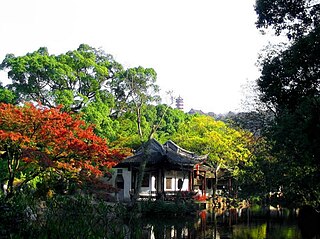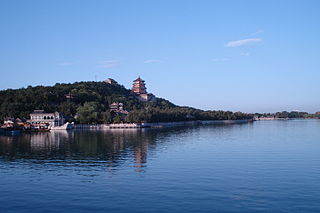
The Summer Palace is a vast ensemble of lakes, gardens and palaces in Beijing. It was an imperial garden in the Qing dynasty. Inside includes Longevity Hill Kunming Lake and Seventeen Hole Bridge. It covers an expanse of 2.9 square kilometres (1.1 sq mi), three-quarters of which is water.

Suzhou, alternately romanized as Soochow, is a major city in southern Jiangsu province, East China. Suzhou is the most populous city in Jiangsu, and a major economic center and focal point of trade and commerce.
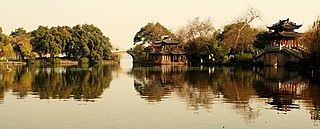
West Lake is a freshwater lake in Hangzhou, China. It is divided into five sections by three causeways. There are numerous temples, pagodas, gardens, and natural/artificial islands within the lake. Gushan (孤山) is the largest natural island and three artificial islands: Xiaoyingzhou (小瀛洲), Huixin Pavilion (湖心亭), and Ruan Gongdun (阮公墩) stand at the middle of the lake. Leifeng Pagoda (雷峰塔) and Baochu Pagoda (保俶塔) are separated by the lake. Mirroring each other, the basic pattern of "one mountain, two towers, three islands, three banks, and five lakes" is formed.

Wuxi is a city in southern Jiangsu province, eastern China, 135 kilometers (84 mi) by car to the northwest of downtown Shanghai, between Changzhou and Suzhou, and one of the central cities in the Yangtze River Delta. It is the ancient founding capital of the state of Wu and the origin of Jiangnan. As of the 2020 census, the city had a total population of 7,462,135 inhabitants.

Changshu is a county-level city under the jurisdiction of Suzhou, Jiangsu province, and is part of the Yangtze River Delta. It borders the prefecture-level city of Nantong to the northeast across the Yangtze River. Due to the mild climate and terrain there, it has enjoyed a high level of agricultural civilization since ancient times, and is named after this, for the first character of its name means "always, often", while the second means "ripe". The name of the adjacent county-level city of Taicang means "great granary".
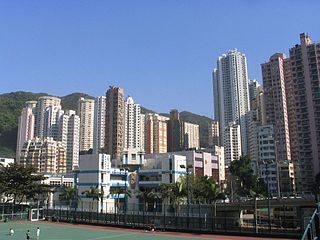
Tai Hang is an area southeast of Causeway Bay located in the mid-north of Hong Kong Island in Hong Kong. It is home to many luxurious private apartments. Residents are predominantly more affluent Hong Kong locals and expatriate professionals.
Xishan may refer to the following locations in China:

The Western Hills are the hills and mountains in the western part of Beijing.

Lingyan Temple is a Buddhist temple located in Changqing District, Jinan, Shandong Province, China, about 20 kilometres (12 mi) north of the city of Tai'an. The temple grounds are situated in a valley on the western edge of the Taishan range. The Lingyan Temple has a long recorded history, and was one of the main temples in China during the times of the Tang and Song Dynasties. Its most renowned landmarks are the 11th century Pìzhī-tǎ and the Qiānfó-diàn which houses a Ming dynasty bronze Buddha statue as well as 40 painted clay statues of life-size luohan from the Song dynasty.

The Chinese Plum Garden is a botanical garden on Lake Tai in Jiangsu, China. It is most prominent in spring when 4000 fruit trees blossom in the park.
The Eight Views of Ram City, also known as the Eight Sights of Guangzhou is the collective name for various collections of the eight most famous tourist attractions in Guangzhou, China, during different periods of its history. Collections of "Eight Views" is a common trope in Chinese travel literature.

The Second Spring or Second-best Spring under Heaven is the name of a spring in Xihui Park at the foot of Mount Hui. The park is located in western Wuxi in eastern China's Jiangsu province.
Huishan National Forest Park is a Chinese park in western Wuxi, Jiangsu Province, China. It is adjacent to Xihui Park.
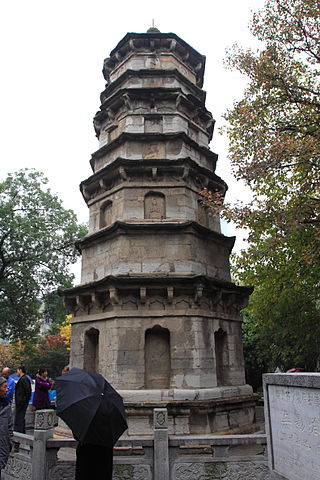
The Wuying Pagoda, also known as the Xingfu Temple Pagoda and The Thousand Year-Old Pagoda of Wuhan, is a Buddhist pagoda in Wuchang, Wuhan, Hubei Province, China. Built of stone 750 years ago during the final years of the Southern Song Dynasty, it is the oldest standing architectural feature in Wuhan. Wuying Pagoda is a Major Historical and Cultural Site Protected at the National Level.

The Shrine of Living Buddha is a Buddhist temple located at the Divine Light Summit (神光岭) of Mount Jiuhua, in Qingyang County, Anhui, China.

Lingguang Temple is a Buddhist temple located on the east hillside of Mount Cuiwei (翠微山), in the Shijingshan District of Beijing. The temple is renowned for its collection of the tooth relic of the Buddha.
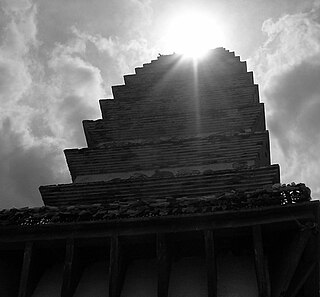
Tongwadian, also known as Jinding Temple, is a Buddhist temple located on Mount Jizu, in Dali Prefecture, Yunnan, China.










